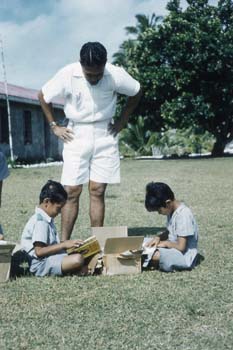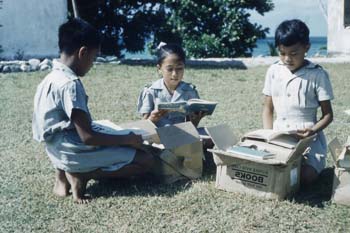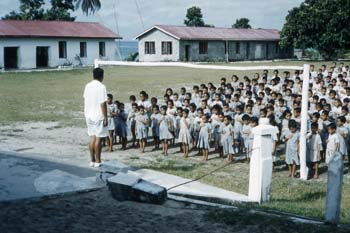The photo essay below is the seventh installment of a personal account of my two years in Fiji and Rotuma from October 1959 through August 1961. The main purpose of this project is to provide photographic images that might be of interest to contemporary Rotumans.
I have forgotten the names of some of the people who appear in the photos and would welcome your help in identifying them. Information identifying people should be sent to <ahoward@hawaii.edu> Please identify the photos by the numbers (#) in the captions.
Episode 7: The Schools
 |
#354 Hanfiro Kitione in class |
One of my interests when I went to Rotuma was to find out as much as I could about the way children learned, and the ways in which the culture was transmitted from generation to generation. I also wondered about the schools and how formal schooling contrasted with the ways children learned informally within their families. As a result I spent a fair amount of time at the schools, talking with teachers and observing what went on within classrooms.
 |
#363 Primary School Teacher (Is this Emily Emose?) |
I was really impressed with how dedicated the teachers were and how bright the students. It was amazing when you think of it. The schools had very few books or supplies. There were no duplicating machines, so when a teacher needed to have copies of something for the students he or she had to make copies by hand. Yet despite these difficulties, Rotumans excelled at the national exams, with among the highest pass rates in all of Fiji. This, despite the fact they were competing against schools like Queen Victoria, Adi Cakabau, Marist, and other elite schools in Fiji.
I was concerned about the lack of books and wanted to do something to help, so I wrote to the pastor at a church in California, suggesting that he initiate a book collection among school children as a project, and have the books sent to Rotuma. He was enthusiastic about the idea, and a couple of months later several boxes of books arrived. There weren't a whole lot of books, but at least there was enough to start a small library.
 |
 |
#sc05 Wilson Inia watching children opening
book boxes from America |
#sc06 Malhaha school children
examining books from America |
Wilson Inia, who had founded the high school and was its principal at the time, invited me to talk to the teachers at one of their monthly meetings. He asked me to tell them about the American system of education, which I did to the best of my ability. I told them about the old and new schools of thought with regard to education in the USA--the old school emphasizing the teaching of skills and achievement, the new school emphasizing social adjustment and productiveness. Master Inia and the others listened attentively, and I remember his saying that the transition in educational philosophy was affecting Rotuman teachers, too. He said that they had decided to use the new techniques as much as possible, but that whenever they got anxious they tended to fall back on the old techniques, pointing out that they had to prepare the children for national examinations. He was a very wise man and a great teacher, as was his wife, Elisapeti.
 |
 |
#360 Elisapeti Inia teaching class 7 |
#355 John Fatiaki at Paptea School |
The school children also impressed me with the dedication and ambition they brought into the schoolroom. It wasn't just that they wanted to succeed as individuals; they wanted an education so that they could better serve their communities. When I asked them what they wanted to be when they grew up, a surprising number answered that they would like to become doctors, nurses, teachers, and serve in other professions that would benefit their people.
 |
 |
#sc01 Wilson Inia at morning assembly |
#357 Faga Solomone teaching class 6 |
 |
 |
#365 Fauoro at her desk |
#356 Form III - Back row Left to right: Aisea
Aitu (Form Teacher), Aisake Tigarea (Itumuta), Emose Sikuri (Paptea),
Makrava (Kalvaka), Jone Hereniko (Hapmak), Petueli Natanela (Noatau),
and Tomasi Sumasafu (Malhaha) Middle row Left to right: Betty Konousi (Motusa), Lora Emeli (Noatau), Saverine Fatiaki (?) (Motusa), Luise Elaise (Itumuta), and Vasiti Inoke (Motusa). Front row Left to right: Firomena Marseu (Noatau), Lijiana Tutoko (Itumuta), Ravkaefono Mitchel (Malhaha) and Kijiana Vamarasi (Itumuta). |
 |
 |
#346 Children at Upu Primary School |
#347 Children at Upu Primary School |
 |
 |
#358 Children at Malhaha Primary School |
#352 Form III students at Malhaha High School |
When I look back now I realize just how successful those teachers were in the 1960s, and how hard those children must have worked, because Rotumans have become among the best educated and most successful people in the Pacific Islands. There's much to be proud of!